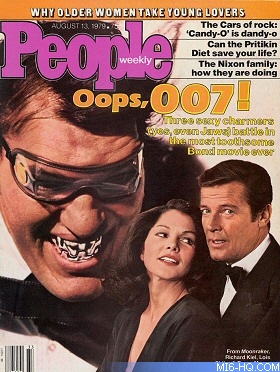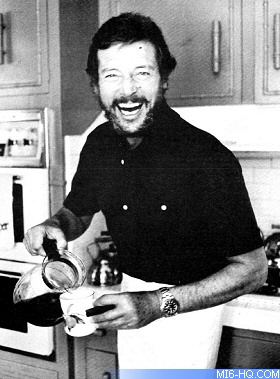 |
| |
People magazine featured "Moonraker" in August 1979
with interviews from Roger Moore, Lois Chiles and
Richard Kiel...
|
|
Time Tunnel: People "Moonraker"
26th May 2009
Moonraker Feature (People Magazine -August 13, 1979)
It was the only exotic locale left un-plumbed in 10 previous movies. So James
Bond reaches the climactic clinch of the 11th, Moonraker, weightless in outer
space. Sure the wooing, like the film itself, has to be rated ZG (zero gravity),
but as their orbits entwine, Holly Goodhead, his latest lovely, sighs: "Take
me around the world one more time, James." Judging from the box office
($39 million the first month), Holly is speaking for movie fans everywhere.
Moonraker is going to be the biggest Bond ever.
Agent 007 apparently doesn't get older,
just suaver and more commercial—goons, gadgets, girls, excruciating
double entendres and all. But inflation, including that
of audience expectations, may make Moonraker less profitable
than some of its lower-grossing predecessors. The original,
Dr. No, was shot for a mere $1 million in 1962. Moonraker
cost $30 million. "I once made entire movies for less
than the phone bills on this one," moaned producer
Albert "Cubby" Broccoli. In any case, a 12th
Bond, For Your Eyes Only, is in the works. "The fantasy, "beams
Broccoli, "continues." The only element that may be aging is Roger Moore, who
at 51 has weathered four 007 epics. That levitating love
scene in Moonraker was done with wires, and the lady, Lois
Chiles, tattles: "Poor Roger was trying to look amorous
when in fact he was terribly miserable." Even he admits: "I'm
always amazed when I read the obituary column that I'm
not mentioned." Roger survived Moonraker with nothing
worse than football knee from scrambling atop the Rio funicular
with Chiles ("She was very brave—and shortsighted,
which helps"). |
|

Above: People Magazine (August
13, 1979)
|
His closest call came in The
Man With The Golden Gun, when he and Britt Ekland almost detonated on an island in
the Gulf
of Siam. "They always record things like that with five
cameras," deadpans Moore. "In case you're killed they've
got enough for a snuff movie."
With a seven-figure salary plus percentage (he won't be more
precise, because "It's vulgar, like discussing your sex
life"), Moore can stand the heat. He's grateful, though,
that invidious comparisons to predecessor Sean Connery are no
longer inevitable. Only his son Christian, 5, is still confused. "That's
you, but you've got a mask on," he told his father while
watching a videotape of the original 007. (Ironically, Connery,
who bowed out fearing typecasting in 1971, is now being sued
for trying to shoot a James Bond of his own.) Asked about the
difference between them, Moore shrugs: "Some people prefer
Olivier's Hamlet, and some Gielgud's."
|

Above: "Bearded for a role,
Roger Moore just shaved a la Reynolds on a TV talk show.
He swigs coffee despite insomnia."
|
|
The only child of a London bobby, Roger
was variously a cartoonist, dishwasher, army officer, student
at the
Royal Academy of Dramatic Art and model. He made his film
debut in a Caesar and Cleopatra crowd scene in 1946. Then,
after a brief Broadway career (he closed in one night),
Moore went to Hollywood as a contract actor. While shooting
an "awful" film called The Rape of the Sabines
in Italy, Moore (divorced from skater Doom Van Steyn and
separated from singer Dorothy Squires) met actress Luisa
Mattioli, now 43. She moved in and gave birth to Deborah,
now 16, and Jeffrey, 13, before they made it legal eight
years later in 1969. Along the way Moore has made 23 movies
and a string of TV series, including The Saint. Roger's Bondage is nonexclusive, and he's mulling Broccoli's
next. "Someday I'll be too old," he concedes.
Eventually Moore wants to direct, as he often did on The
Saint. (A former European exec for Brut Productions, he
helped put together A Touch of Class.) Roger paints, plays
guitar "rather badly" and keeps up an exercise
regimen "every morning—well, most every morning." He
used to play roulette, but cracks, "I retired from
the tables—shaken, but not stirred." |
The Moores pal around with the Gregory Pecks and Kirk Douglases,
while jetting between houses in the South of France, Italy and
Switzerland. "I'm never quite sure where the bathroom is," he
claims. "If I ever settle down, three airlines are going
to go broke."
Lois Chiles also has no fear of flying. Director Lewis Gilbert
recalled her roles with Robert Redford in The Way We Were and
The Great Gatsby when he sat next to her on a plane, and later
asked her to test for Moonraker. No matter that the likes of
Faye Dunaway, Catherine Deneuve and Raquel Welch have spurned
offers to play Bond girls. "I needed the work, I needed
the money and I needed the experience," says Chiles, 32.
And while Bond is as chauvinist as ever, scientist/CIA agent
Holly Goodhead ("Can you believe that name?" asks Lois)
is his brainiest bedmate to date. "This time they made her
more of a partner," she says.
At first that troubled Moore, who harrumphs: "I'm a little
older and more experienced, so I think I can push the actresses
around a little. The trouble is, they push back, most of them.
Bloody women's lib!" Lois was so serious about her part
that Roger began calling her "Sarah Bernhardt Chiles."
There was another reason Chiles poured herself into her work:
Her younger brother, Clay, was suffering from Hodgkin's disease.
Lois shuttled from L.A. to Texas to give him blood until he died
two months ago at 25. "Before, I would get in a state over
something at the cleaner's," she says. "Those things
don't bother me now. If you accept that at any time you could
die, it makes each day special."
Daughter of an oilman from Alice, Texas, Lois grew up a "culturally
deprived tomboy: I wanted to be a wild black stallion that nobody
could ride." After attending the University of Texas (Farrah
Fawcett was then "the campus beauty"), Chiles left
for New York and fell into modeling when Glamour spotted her
in Finch College's cafeteria. Chanel, Revlon and Clairol ads
let her study with Sandy Meisner.
A year ago Chiles met Don Henley, 32, the drummer with the Eagles,
in her exercise class. "My image of musicians," remembers
Lois, "was of groupies, tearing up airplanes and trashing
hotels. That was the last thing I wanted to get involved with." But
she did. She doesn't tour with the group ("Concerts are
interesting the first few times"), though she and her dog,
Ursula, guested at his Holmby Hills manse before finding their
own cottage last month in Santa Monica. "I love him very
much," she says, but has no plans for marriage or children.
When they're together Chiles lets Henley cook. "I hate roles
in relationships," notes Lois. "I like roles if you're
being paid."
Stardom—which she believes "is elevated to undeserved
importance"—Chiles can do without. "It's fun
to be at the Plaza and whisked off in a limousine, but I'd hate
to wake up at 60 and find I'm a dull person."
Richard Kiel: his bite is worse than his bark
According to Broccoli's Law, no starring sex object or villain
ever comes back for a second shot in the series. Richard "Jaws" Kiel,
39, wasn't even invited at first to attend the premiere of his
Bond debut, The Spy Who Loved
Me. But the fans so resoundingly
took to the 7'2", 315-pound character that the producer
realized a good thing when he was dwarfed by it. This outing,
Jaws got a love interest and even speaks for the first time:
four words to his lady. There was a price for his expanded role:
He could wear the cobalt steel dentures for only three minutes
and still would end up sick to his stomach.
"Every actor wants to stand out," drawls Kiel (rhymes
with zeal), but being typed into hulking but small parts has
troubled him. He longs to play Othello or a "Dustin Hoffman-type
role. I'm an intelligent and sensitive person," he protests. "I've
had a lot of directors who are surprised I can even walk." Broccoli
knows better, calling Richard "an intelligent, gentle man
and a very good actor, particularly in Chaplinesque situations."
Born in Michigan, Kiel grew up and up in East Los Angeles, where
his father owned an appliance store. Some family members were
tall, but "when I was 12 my father got slightly concerned
because I started to wear all his clothes. That lasted for about
a month," he chuckles. Richard was 6'7" by age 14. "Bashful" in
high school, he reports that "the only thing I knew about
girls was that they danced backward."
He drifted as a washing machine repairman, cemetery plot salesman
("That was better than studying acting in New York"),
radio school teacher and bouncer until 1960, when he picked up
$500 as a brawler on TV's Klondike series. Kiel says his debut
was "terrible," but he got work as a TV heavy until
1968, when he found he could make more money selling cars and
then real estate.
Kiel returned to the screen for 1974's The Longest Yard, where
Burt Reynolds, a mentor to so many actors, told him, "Hang
in there." On location in Georgia, the divorced Kiel also
met high school student Diane Rogers, 16 years younger and 25
inches shorter than he. "It was just boom," he recalls.
They were married a year later. "I'm sure that one of the
things that attracts her to me is that she feels safe at night."
The Kiels now include Richard George, 4½, Jennifer, 2½,
and Bennett, 9 months, and live in Covina, an unchic L.A. suburb.
They have a second place: not a Malibu beach house but a mobile
home in the desert. "Diane's the kind of gal who could be
happy if we lived in a tin shack as long as we could pay the
light bill," he says. Their pleasures are cycling, horseback
riding, watching TV and vanning. Another Kiel movie, "a
spaghetti Star Wars" called The Humanoid, is already out
abroad, and he has formed a production company to seek out more
serious properties. "My motto," he says, "is 'Think
small.' "
Fortunately, though, for Kiel, the Cubby Broccolis of this world
never do.
Related Articles
 Moonraker
- Movie Coverage
Moonraker
- Movie Coverage